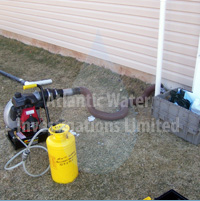|
|
Wells
Buried Well Cables & Water Lines Locating
When Conducting Buried Well Cables\Water
Lines Location Services:
-
Jet Pump System
- plumber needs to be retained by client to remove hose to make pipe accessible
for equipment
- upon completion of location services work, plumber needs to
be retained by client to attach hose and prime pump
-
Submersible Pump System
Locate Buried Well Cables\Water Lines
There are a number of different locating methods
and the method or combination of methods used will be determined on
a number of factors which can only be determined by an on-site
visit. The exact or estimated time depends on a number of factors
which can only be determined by an on-site visit. Can you tell us
everything (every nail, wire, metal, etc) that is buried under your
property? If you know that, then we can eliminate those areas to
dig. Basically you need to ask yourself how much digging do you want
to do? Because, no matter what, you will have to dig up the buried
cable, pipe, well which will eventually be found.
The work will provide you with:
- information to determine if the pipe ends immediately below the basement floor
- if the pipe extends beyond the basement floor and the general direction of the
buried pipe under the basement floor
- the general direction of the water
line leading to the buried well to be located
- the general location or
location(s) of the termination point of the signal which may or may not be the
buried well
The factors that affect the precise
pinpointing are:
- type of pipe in the ground, plastic, metal, combination
- pipe connectors,
plastic, metal, combination
- straight run of pipe or bends or turns off at
an angle or more than one angle
- maybe inside a concrete crock, buried near
the surface or greater than 4 feet depth (frostline)
- electrical wires
overhead and buried underground, and metal fences
- blockages in pipes in
that the tracing signal will stop where the tape or "snake" ends at the stoppage
- the presence of conductive soil (those with high mineral salt content and
usually rather damp)
There is no guarantee in location and how much
time it will take. The work may be straight forward and we can
locate the buried object in an hour. The work may be more
complicated and there may be unknown factors that will affect the
pinpointing of the object and take a couple of hours. The time it
takes will depend on whether you want us to do the digging or you
take care of the digging. The time it takes depends on difficulty of
soil to dig up the ground (there may be hard soil like clay or mud,
soft soil like sand, water logged soil, frozen soil, boulders and
rocks, or a combination of soil types); depth of buried object (it
may be near the surface or several feet under) and we may need to do
more than one spot dig to verify the general direction and location
of the buried well. Our equipment will detect almost all buried
cables, pipes, tanks and most conductors, but there are some which
do not radiate signals which cannot be detected. Our equipment does
not indicate whether a signal is from a single cable, line, pipe, or
several buried side by side or one above the other.
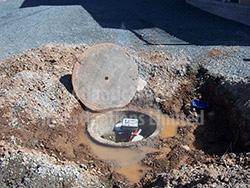 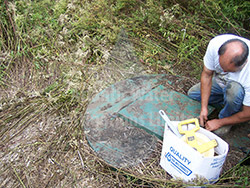
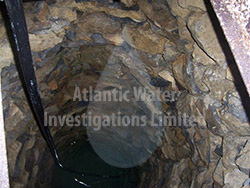 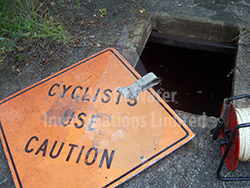
We have all the pipe and cable locating equipment
necessary to conduct the locating. The types of equipment we use
have found wires and cables underground; metal pipes, underground
valve boxes, cast iron pipe to a depth of 10 feet, plastic and clay
pipe to 20 feet; buried wells, and storage tanks. Our equipment uses
the following locating and tracing methods:
- Inductive tracing method; where no direct connection between the pipe and the
transmitter is necessary. We first find the starting point using a 3 piece
handle. Once the starting point is established, linear locating of the pipeline
can begin.
- Conductive locating method; is the preferred tracing method
because the transmitter makes a direct physical hook-up with the line to be
traced. The included wire and alligator clip is connected from the transmitter
to the pipe, non-energized wire, metallic locator tape (electricians fish tape),
or conduit. This concentrates the signal on the known line to be traced and
there is less chance of the signal inducing a nearby or adjacent line to cause
confusion. Non-metallic pipe may be traced conductively if the connecting wire
is attached to a plumber's "snake" or electrician's "fish tape" running inside
of pipe. The three piece handle is required for one man inductive tracing when
neither end of the lost conductor is known.
- Digital signal processing and
microprocessor control locator, (not analog meters) with a built in 3 way signal
finder in combination with the pipeline colour camera that has a built in signal
transmitter lets us know exactly where the pipe is. No guess work involved. When
we turn on the locator, it looks for a signal transmitted from the camera. We
can switch to another signal when we are looking for high resistance conductors
and larger diameter pipes. We can even locate live power lines, fiber optic
lines and CATV cables without using an external transmitter. With the push of a
button the locator will instantly tell the depth of the camera in the pipe down
to the inch. No triangulation required. We can locate cast iron pipe to a depth
of 10 feet and plastic and clay pipe to 20 feet, with the camera and locator.
We have all the pipe and cable locating equipment
necessary to conduct the locating. Two types of equipment we use
are:
- which finds pipes, cables and
underground valve boxes. Crystal controlled 82 kilohertz (Khz)
frequency assures that transmitter and receiver stay precisely
tuned. Minimum operating range without interference challenges
is 20 feet up to a maximum of 1000 feet. Versatile split box
design allows for both inductive and conductive locating
methods. Inductive method is where no direct connection between
the pipe and the transmitter is necessary. We first find the
starting point using a 3 piece handle. Once the starting point
is established, linear locating of the pipeline can begin.
Conductive method is the preferred tracing method because the
transmitter makes a direct physical hook-up with the line to be
traced. The included wire and alligator clip is connected from
the transmitter to the pipe, non-energized wire, metallic
locator tape (electricians fish tape), or conduit. This
concentrates the signal on the known line to be traced and there
is less chance of the signal inducing a nearby or adjacent line
to cause confusion. Non-metallic pipe may be traced conductively
if the connecting wire is attached to a plumber's "snake" or
electrician's "fish tape" running inside of pipe. The three
piece handle is required for one man inductive tracing when
neither end of the lost conductor is known.
- Pipe and Cable Locator has digital signal
processing and microprocessor control, (not analog meters) which provide the
user with a locator that has more selectivity and faster processing. The locator in combination with the camera that has a 512 hz signal transmitter lets
us know exactly where the pipe is. No guess work involved. The LCD display gives
a digital signal readout as well as a graphic display and audible tone. A broad
range of settings lets us home in to the exact location of the transmitter. The locator can locate almost anything underground with its built-in three
way signal finder. We can locate the camera even when it's deep underground
inside cast iron pipe. When we turn on the locator, it looks for a 512 hz signal
transmitted from the camera. Switch to the 65 Khz signal when we are looking for
high resistance conductors and larger diameter pipes. We can even locate live
power lines, fiber optic lines and CATV cables in the 60 hz mode without using
an external transmitter. With the push of a button locator will
instantly tell the depth of the camera in the pipe down to the inch. No
triangulation required. We can locate cast iron pipe to a depth of 10 feet and
plastic and clay pipe to 20 feet, with the camera and locator.
|
|
 |
